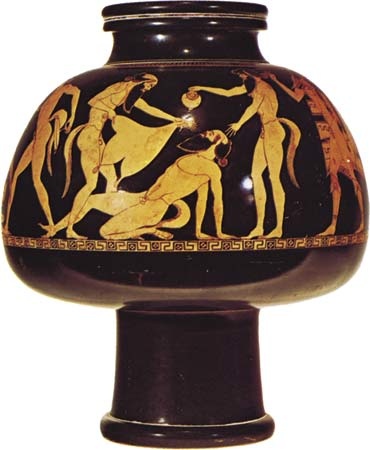Satyr and Silenus
Greek mythology
 in Greek mythology, creatures of the wild, part man and part beast, who in Classical times were closely associated with the god Dionysus. Their Italian counterparts were the Fauns (see Faunus). Satyrs and Sileni were at first represented as uncouth men, each with a horse's tail and ears and an erect phallus. In the Hellenistic age they were represented as men having a goat's legs and tail. The occurrence of two different names for the creatures has been explained by two rival theories: that Silenus was the Asian Greek and Satyr the mainland name for the same mythical being; or that the Sileni were part horse and the Satyrs part goat. Neither theory, however, fits all the examples in early art and literature. From the 5th century BC the name Silenus was applied to Dionysus' foster father, which thus aided the gradual absorption of the Satyrs and Sileni into the Dionysiac cult. In the Great Dionysia festival at Athens three tragedies were followed by a satyr play (e.g., Euripides' Cyclops), in which the chorus was dressed to represent Satyrs. Silenus, although bibulous like the Satyrs in the Satyr plays, also appeared in legend as a dispenser of homely wisdom.
in Greek mythology, creatures of the wild, part man and part beast, who in Classical times were closely associated with the god Dionysus. Their Italian counterparts were the Fauns (see Faunus). Satyrs and Sileni were at first represented as uncouth men, each with a horse's tail and ears and an erect phallus. In the Hellenistic age they were represented as men having a goat's legs and tail. The occurrence of two different names for the creatures has been explained by two rival theories: that Silenus was the Asian Greek and Satyr the mainland name for the same mythical being; or that the Sileni were part horse and the Satyrs part goat. Neither theory, however, fits all the examples in early art and literature. From the 5th century BC the name Silenus was applied to Dionysus' foster father, which thus aided the gradual absorption of the Satyrs and Sileni into the Dionysiac cult. In the Great Dionysia festival at Athens three tragedies were followed by a satyr play (e.g., Euripides' Cyclops), in which the chorus was dressed to represent Satyrs. Silenus, although bibulous like the Satyrs in the Satyr plays, also appeared in legend as a dispenser of homely wisdom.In art the Satyrs and Sileni were depicted in company with nymphs or Maenads whom they pursued. (Their amorous relations with nymphs are described as early as the Homeric Hymn to Aphrodite.) The Greek sculptor Praxiteles represented a new artistic type in which the Satyr was young and handsome, with only the smallest vestiges of animal parts. Hellenistic artists developed that concept into humorous or forceful representation of half-animal subjects as an escape from the merely human.
- Valeriano Weyler y Nicolau, Marqués De Tenerife
- Valerie Ann Amos, Baroness Amos of Brondesbury
- Valerie Ann, Baroness Amos of Brondesbury Amos
- Valerie Jarrett
- Valerius Flaccus, Gaius
- Valerius Maximus
- Valero, Roberto
- Vale Royal
- Valery Borzov
- Valery Brumel
- Valery Bykovsky
- Valery Kubasov
- Valery-Nicolas Larbaud
- Valery Vladimirovich Polyakov
- Valery Yakovlevich Bryusov
- Valhalla
- Valignano, Alessandro
- Valindaba
- valine
- Valium
- Valkyrie
- Vallabha
- Vallabhbhai Jhaverbhai Patel
- Vallabhācārya
- Valladolid